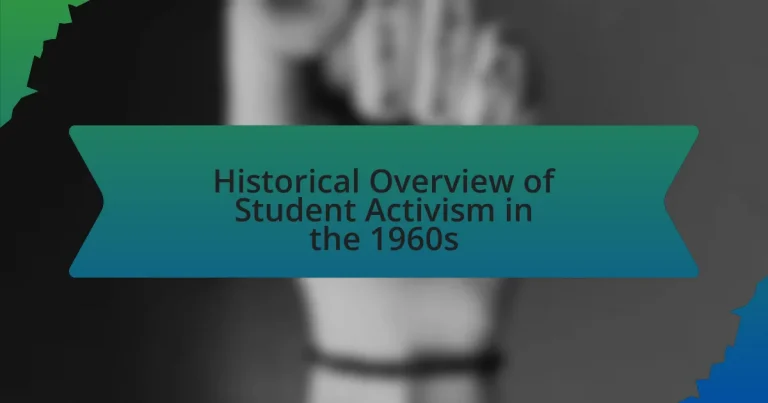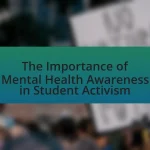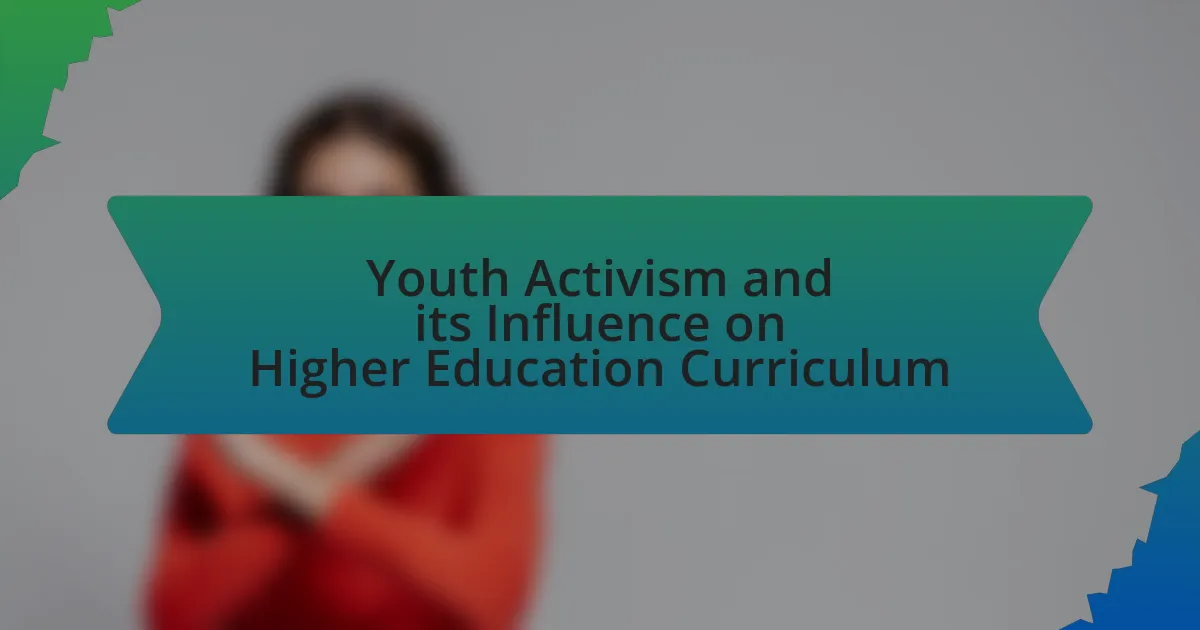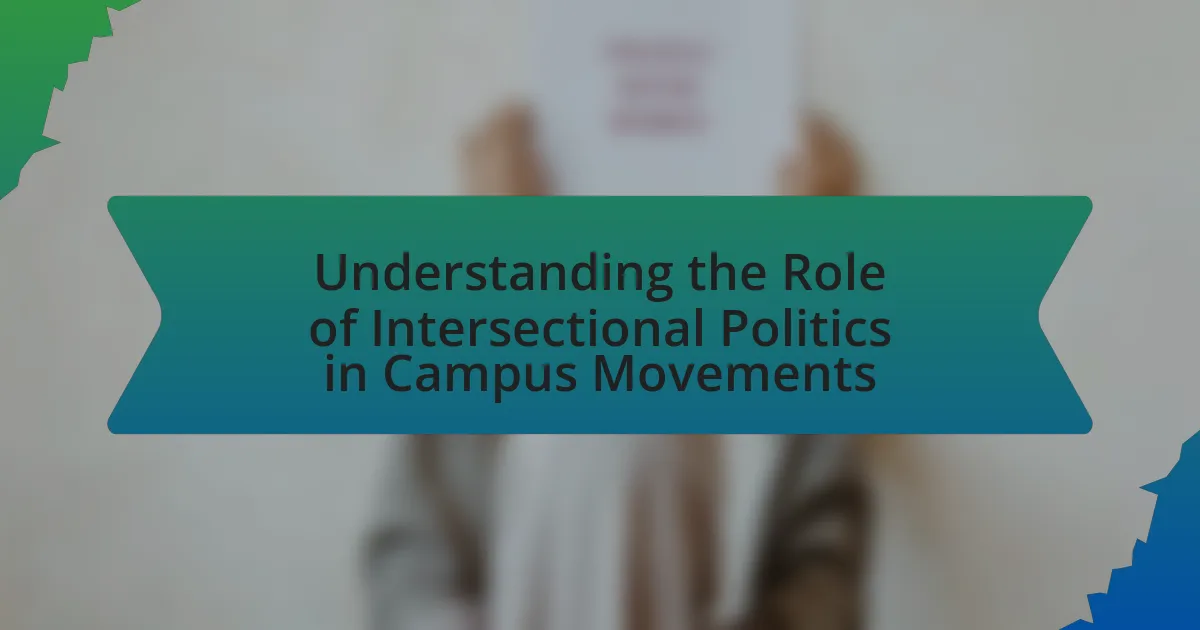The article provides a historical overview of student activism in the 1960s, highlighting its emergence as a response to social injustices, political unrest, and the Vietnam War. It discusses key events such as the formation of the Students for a Democratic Society (SDS), the Free Speech Movement at the University of California, Berkeley, and significant protests against U.S. military involvement in Vietnam. The article examines the influence of the civil rights movement on student activism, the major organizations involved, and the challenges faced by activists, including government repression and internal conflicts. Additionally, it addresses the impact of student activism on society and politics, including legislative changes prompted by these movements, and offers insights into the lessons current activists can learn from this historical context.

What is the Historical Overview of Student Activism in the 1960s?
Student activism in the 1960s was characterized by a surge of political engagement among youth, primarily driven by opposition to the Vietnam War, civil rights movements, and demands for educational reform. Key events included the formation of the Students for a Democratic Society (SDS) in 1960, which advocated for participatory democracy and social justice, and the widespread protests against U.S. military involvement in Vietnam, culminating in significant demonstrations such as the 1968 Democratic National Convention protests in Chicago. The era also saw the rise of the Free Speech Movement at the University of California, Berkeley, which challenged restrictions on political activities on campus. These movements collectively influenced public policy and contributed to a broader cultural shift towards activism and social change, reflecting the growing discontent with governmental authority and societal norms during that decade.
How did student activism emerge during the 1960s?
Student activism emerged during the 1960s as a response to social injustices, political unrest, and the Vietnam War. The civil rights movement, which sought to end racial segregation and discrimination, galvanized students across the United States, leading to organized protests and sit-ins. Events such as the 1964 Free Speech Movement at the University of California, Berkeley, highlighted students’ demands for political expression and academic freedom. Additionally, the anti-war movement gained momentum as students opposed U.S. involvement in Vietnam, culminating in large-scale demonstrations, such as the 1969 Moratorium to End the War in Vietnam, which drew millions of participants nationwide. These movements collectively marked a significant shift in student engagement, transforming campuses into centers of political activism and social change.
What social and political factors contributed to the rise of student activism?
The rise of student activism in the 1960s was primarily driven by social movements advocating for civil rights, anti-war sentiments, and a growing counterculture. The civil rights movement, exemplified by events like the March on Washington in 1963, inspired students to challenge racial injustice and demand equality. Additionally, opposition to the Vietnam War galvanized students, leading to widespread protests, such as the Kent State shootings in 1970, which highlighted the consequences of military engagement. The counterculture movement, characterized by a rejection of traditional values and an embrace of alternative lifestyles, further motivated students to engage in activism, seeking social change and greater personal freedoms. These factors collectively created a fertile ground for student activism, as young people sought to influence societal norms and government policies.
How did the civil rights movement influence student activism?
The civil rights movement significantly influenced student activism by inspiring young people to engage in social justice issues and civil rights advocacy. This movement, particularly during the 1960s, demonstrated the power of collective action and nonviolent protest, which motivated students to organize their own initiatives, such as sit-ins and protests against racial segregation and inequality. For instance, the Student Nonviolent Coordinating Committee (SNCC), formed in 1960, was a direct result of the civil rights movement and played a crucial role in mobilizing students across the country to participate in civil rights activities, including the Freedom Rides and voter registration drives. The success of these efforts showcased the effectiveness of grassroots organizing and encouraged students to address a broader range of issues, including anti-war protests and women’s rights, thereby shaping the landscape of activism in the 1960s.
What were the key events in student activism during the 1960s?
Key events in student activism during the 1960s include the Free Speech Movement at the University of California, Berkeley in 1964, which advocated for students’ rights to engage in political activities on campus. This movement sparked widespread protests and led to significant changes in university policies regarding free speech. Another pivotal event was the anti-Vietnam War protests, particularly the 1965 march on Washington, D.C., organized by students and various activist groups, which drew hundreds of thousands of participants and highlighted the growing opposition to U.S. involvement in Vietnam. Additionally, the Kent State shootings in 1970, where four students were killed by National Guardsmen during a protest against the war, galvanized national outrage and further intensified student activism across the country. These events collectively marked a transformative period in student activism, characterized by a strong push for civil rights, anti-war sentiments, and greater political engagement among youth.
Which protests and demonstrations defined the era?
The protests and demonstrations that defined the era of student activism in the 1960s include the Civil Rights Movement, the anti-Vietnam War protests, and the Free Speech Movement. The Civil Rights Movement, particularly events like the March on Washington in 1963, mobilized students to advocate for racial equality and justice. The anti-Vietnam War protests, notably the 1968 Democratic National Convention protests in Chicago, saw significant student involvement against U.S. military intervention in Vietnam. The Free Speech Movement at the University of California, Berkeley, in 1964 emphasized students’ rights to free expression and political activism on campus, leading to widespread changes in university policies. These movements collectively shaped the political landscape and social consciousness of the 1960s, reflecting a period of intense activism and societal change.
How did the Vietnam War impact student activism?
The Vietnam War significantly intensified student activism in the 1960s. As the conflict escalated, students became increasingly vocal against U.S. military involvement, leading to widespread protests on college campuses. For instance, the Students for a Democratic Society (SDS) organized the 1965 anti-war march in Washington, D.C., which drew thousands of participants and marked a pivotal moment in the anti-war movement. Additionally, the Kent State shootings in 1970, where four students were killed during a protest, galvanized national outrage and further mobilized student activism across the country. This period saw the emergence of a more politically engaged youth, advocating for peace and social justice, fundamentally reshaping the landscape of American activism.
What were the major organizations involved in student activism?
The major organizations involved in student activism during the 1960s included the Student Nonviolent Coordinating Committee (SNCC), the Students for a Democratic Society (SDS), and the National Student Association (NSA). SNCC played a crucial role in civil rights activism, organizing voter registration drives and protests against segregation. SDS was instrumental in anti-war protests, particularly against the Vietnam War, advocating for participatory democracy and social justice. The NSA focused on representing student interests and promoting civil rights, influencing national policy through student-led initiatives. These organizations collectively shaped the landscape of student activism in the 1960s, addressing issues of civil rights, war, and democracy.
What roles did groups like SDS and SNCC play in the movement?
Groups like the Students for a Democratic Society (SDS) and the Student Nonviolent Coordinating Committee (SNCC) played pivotal roles in the civil rights and anti-war movements of the 1960s. SDS focused on promoting participatory democracy and mobilizing students against the Vietnam War, organizing events like the 1965 anti-war march in Washington, D.C., which drew thousands of participants. SNCC, on the other hand, was instrumental in grassroots organizing for civil rights, leading initiatives such as the Freedom Rides and the voter registration drives in the South, which significantly increased African American voter registration. Both organizations exemplified the power of student activism, influencing public opinion and policy through direct action and grassroots mobilization.
How did these organizations mobilize students across the country?
Organizations mobilized students across the country through coordinated campaigns, grassroots organizing, and the use of media. For instance, the Student Nonviolent Coordinating Committee (SNCC) and the Students for a Democratic Society (SDS) utilized campus networks to disseminate information about civil rights and anti-war initiatives, effectively reaching thousands of students. They organized sit-ins, protests, and rallies, which were often publicized through local and national media, amplifying their messages and drawing in more participants. The establishment of national conferences and the creation of pamphlets and newsletters further facilitated communication and engagement among students, fostering a sense of solidarity and urgency around social issues.
How did student activism evolve throughout the decade?
Student activism evolved significantly throughout the 1960s, transitioning from localized protests to a more organized and national movement. In the early part of the decade, student activism was primarily focused on civil rights issues, exemplified by the involvement of students in sit-ins and freedom rides aimed at desegregation. By the mid-1960s, the anti-Vietnam War movement gained momentum, with students organizing large-scale demonstrations, such as the 1965 march on Washington, which drew over 25,000 participants. This period also saw the formation of influential organizations like Students for a Democratic Society (SDS), which advocated for broader social change and political engagement. The decade culminated in the late 1960s with heightened activism surrounding issues like women’s rights and environmental concerns, reflecting a diversification of student interests and a more radical approach to activism. The evolution of student activism during this decade was marked by increased political awareness, solidarity across various movements, and a shift towards more confrontational tactics.
What shifts occurred in the goals and methods of student activists?
Student activists in the 1960s shifted their goals from primarily focusing on civil rights and anti-war efforts to broader social justice issues, including feminism, environmentalism, and anti-imperialism. Initially, student activism was largely centered around the Civil Rights Movement, exemplified by the Student Nonviolent Coordinating Committee (SNCC) advocating for racial equality. However, as the decade progressed, the methods of activism evolved from traditional protests and sit-ins to more radical approaches, including the use of countercultural expressions, music, and media to mobilize support. This shift was influenced by significant events such as the Vietnam War, which galvanized students to adopt a more intersectional approach to activism, addressing multiple societal issues simultaneously. The emergence of organizations like Students for a Democratic Society (SDS) further exemplified this transition, as they expanded their focus to include anti-capitalist sentiments and critiques of U.S. foreign policy.
How did the counterculture movement intersect with student activism?
The counterculture movement significantly intersected with student activism by fostering a shared ethos of rebellion against societal norms and advocating for social change. This intersection was evident during the 1960s, as students became key participants in protests against the Vietnam War, civil rights issues, and the establishment’s conservative values. For instance, the Free Speech Movement at the University of California, Berkeley in 1964 exemplified this connection, as students demanded the right to engage in political activities on campus, reflecting broader countercultural ideals of free expression and anti-establishment sentiments. Additionally, the counterculture’s emphasis on peace, love, and communal living resonated with student-led initiatives, such as the anti-war demonstrations that drew millions, showcasing a unified front against militarism and advocating for social justice.
What challenges did student activists face in the 1960s?
Student activists in the 1960s faced significant challenges, including government repression, societal backlash, and internal divisions. Government repression manifested through surveillance, arrests, and violent crackdowns on protests, as seen during events like the 1968 Democratic National Convention in Chicago, where police violently confronted demonstrators. Societal backlash included criticism from conservative groups and segments of the public who viewed student activism as disruptive, particularly in the context of the Vietnam War. Additionally, internal divisions arose within activist groups over strategies and priorities, leading to fragmentation and weakened movements, as evidenced by the split between more radical factions and those advocating for nonviolent protest.
How did government responses affect student activism?
Government responses significantly influenced student activism by either suppressing or galvanizing movements. For instance, during the 1960s, the U.S. government’s aggressive tactics, such as the deployment of police during protests and the implementation of laws restricting assembly, often led to increased student mobilization and radicalization. The violent response to peaceful demonstrations, such as the Kent State shootings in 1970, sparked widespread outrage and further activism among students across the nation, illustrating how government actions can inadvertently energize movements. Additionally, government policies, like the expansion of civil rights legislation, provided a framework that students could leverage to advocate for social change, demonstrating that responses can also empower activism when aligned with student goals.
What internal conflicts arose within student organizations?
Internal conflicts within student organizations during the 1960s primarily revolved around ideological differences, leadership struggles, and the direction of activism. For instance, groups like the Students for a Democratic Society (SDS) experienced significant rifts between factions advocating for more radical approaches versus those favoring reformist strategies. These divisions often led to debates over issues such as the Vietnam War, civil rights, and the role of student activism in broader societal change. The conflict within SDS culminated in a split in 1969, highlighting the challenges of maintaining unity amidst diverse perspectives on activism and political engagement.
What impact did student activism have on society and politics?
Student activism significantly influenced society and politics by driving social change and shaping public policy during the 1960s. Activists mobilized against issues such as civil rights, the Vietnam War, and educational reforms, leading to landmark legislation like the Civil Rights Act of 1964 and the establishment of affirmative action policies. The protests and demonstrations organized by students, such as the 1968 Democratic National Convention protests, highlighted the growing discontent with government policies and prompted a reevaluation of political priorities. Additionally, student-led movements fostered a culture of political engagement and awareness, encouraging future generations to participate in civic life.
How did student protests influence public opinion on key issues?
Student protests significantly influenced public opinion on key issues by raising awareness and mobilizing support for civil rights, anti-war sentiments, and educational reforms during the 1960s. For instance, the 1964 Free Speech Movement at the University of California, Berkeley, galvanized students to advocate for political expression on campus, which resonated with broader societal demands for free speech and civil liberties. Additionally, protests against the Vietnam War, such as the 1969 Moratorium to End the War in Vietnam, drew millions of participants and shifted public sentiment against U.S. involvement, as evidenced by a Gallup poll showing a decline in support for the war from 61% in 1965 to 28% by 1971. These movements not only shaped public discourse but also pressured policymakers to address the concerns raised by the student activists, leading to significant legislative changes and a reevaluation of national priorities.
What legislative changes were prompted by student activism?
Student activism in the 1960s prompted significant legislative changes, including the Civil Rights Act of 1964 and the Higher Education Act of 1965. The Civil Rights Act was influenced by student-led movements advocating for racial equality, which highlighted the need for federal legislation to prohibit discrimination. Additionally, the Higher Education Act aimed to increase federal funding for education and improve access to higher education, driven by student demands for affordable education and financial aid. These legislative changes were direct responses to the activism and advocacy efforts of students during this transformative period.
How can we learn from the historical overview of student activism in the 1960s?
We can learn from the historical overview of student activism in the 1960s by examining the strategies and outcomes of movements that shaped social and political change. The 1960s saw significant student-led protests, such as the Civil Rights Movement and anti-Vietnam War demonstrations, which utilized tactics like sit-ins, marches, and organized rallies to mobilize public opinion and influence policy. For instance, the 1964 Free Speech Movement at the University of California, Berkeley, highlighted the importance of free expression and political engagement on campuses, leading to broader reforms in university policies nationwide. This historical context illustrates how collective action and grassroots organizing can effectively challenge systemic injustices and inspire future generations to advocate for their rights.
What lessons can current activists draw from the 1960s experience?
Current activists can draw several key lessons from the 1960s experience, particularly the importance of grassroots organizing and coalition-building. The 1960s saw movements like the Civil Rights Movement and anti-Vietnam War protests thrive through local community engagement and collaboration among diverse groups. For instance, the Student Nonviolent Coordinating Committee (SNCC) effectively mobilized students across the South, demonstrating that collective action can amplify voices and drive social change. Additionally, the 1960s highlighted the significance of using various forms of media to spread awareness and galvanize support, as seen with the televised coverage of protests and events that brought national attention to issues. These historical examples underscore the effectiveness of sustained activism, strategic communication, and the power of unity in achieving social justice goals.
How can understanding this history inform future activism strategies?
Understanding the history of student activism in the 1960s can inform future activism strategies by highlighting successful tactics and the importance of coalition-building. For instance, the civil rights movement and anti-war protests demonstrated that organized, collective action can effectively challenge systemic injustices. Historical examples, such as the Student Nonviolent Coordinating Committee (SNCC), reveal that grassroots mobilization and direct action can lead to significant social change. Additionally, analyzing the failures and successes of past movements allows contemporary activists to adapt strategies that resonate with current societal contexts, ensuring relevance and effectiveness in their approaches.




